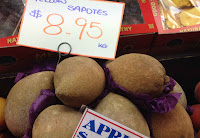A few days later, as we neared the border,
our fourth passenger, the black sapote, was as hard and shiny as it had been
two days before. I tried valiantly
to distract my driver from the ominous quarantine road signs, but he was a
law-abiding man on this occasion and pulled over at a roadside shelter armed
with his pocket-knife. I thought I saw glimpses of dark treasure as the knife
pierced the skin, but I was mistaken.
Instead we were faced with a green watery inedible mass and there was no
hint of chocolate pudding in my first sapote experience.
My second sapote experience happened a few
years later in Ho Chi Minh City on the breakfast table of the majestic Majestic
Hotel. It was the closest thing to
a caramel pudding fruit I had ever tasted, this brown fruit with a fudge-like
grain and the flavour of intense caramel. I returned many times to the breakfast fruit
table and then bribed seven year old Jorge to return on my behalf. The memory of the fruit lingered all morning as we trudged through the humid and noisy streets into Ben Thanh Markets. What delight as I encountered stall after stall selling this
beautiful fruit, the brown sapote, peeled, sliced, bagged and ready to be
eaten.
 Today, I had my third sapote experience. A
hard woody-skinned fruit resembling a sweet potato in size and shape, the
yellow (Mamoy) sapote was on sale for $8.95/kg at Adelaide’s Central Market.
Apparently there is also a white and yellow (not this yellow) sapote. Almost
all the varieties come from Central and South America and are very popular in
South East Asia. The Cambodian fruit stall attendant advised me that the sapote
would not be ready to eat for several days, “when it’s soft”. I am due to
return to Alice Springs in two days and want to avoid another disappointing
sapote episode.
Today, I had my third sapote experience. A
hard woody-skinned fruit resembling a sweet potato in size and shape, the
yellow (Mamoy) sapote was on sale for $8.95/kg at Adelaide’s Central Market.
Apparently there is also a white and yellow (not this yellow) sapote. Almost
all the varieties come from Central and South America and are very popular in
South East Asia. The Cambodian fruit stall attendant advised me that the sapote
would not be ready to eat for several days, “when it’s soft”. I am due to
return to Alice Springs in two days and want to avoid another disappointing
sapote episode.
My senses are drawn to nearby group of people buzzing around a box
of orange shiny fig-sized fruit. “Achacha”, according to the sign. This is the
first year the fruit has been sold, and the achacha has become a celebrity in
its own right, with its own website and television appearances. The name itself
is new, derived from the original: Achachairu. Another native of Central America, Bolivia, the achacha is
covered by a shiny thick bitter skin that peels away easily to reveal a white
fleshy layer around a large brown seed.
My friend, the stall-keeper, describes it as being “like a mangosteen”,
not the most known of fruits. The flesh is sweet with a texture similar to
custard apple but a bit more tang. I’m not disappointed, but it’s not quite the
sapote pudding experience I was hoping for. Perhaps if it had been renamed:
“the vanilla mousse fruit”, rather than the obscure “achacha” I might feel
differently. I think I’ll buy that Mamoy sapote after all.
©
Rita Cattoni 2012









